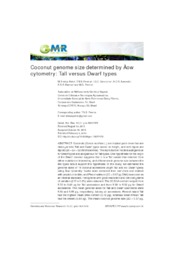Coconut genome size determined by flow cytometry: tall versus dwarf types.
Coconut genome size determined by flow cytometry: tall versus dwarf types.
Author(s): FREITAS NETO, M.; PEREIRA, T. N. S.; GERONIMO, I. G. C.; AZEVEDO, A. O. N.; RAMOS, S. R. R.; PEREIRA, M. G.
Summary: Coconuts (Cocos nucifera L.) are tropical palm trees that are classified into Tall and Dwarf types based on height, and both types are diploid (2n = 2x = 32 chromosomes). The reproduction mode is autogamous for Dwarf types and allogamous for Tall types. One hypothesis for the origin of the Dwarf coconut suggests that it is a Tall variant that resulted from either mutation or inbreeding, and differences in genome size between the two types would support this hypothesis. In this study, we estimated the genome sizes of 14 coconut accessions (eight Tall and six Dwarf types) using flow cytometry. Nuclei were extracted from leaf discs and stained with propidium iodide, and Pisum sativum (2C = 9.07 pg DNA) was used as an internal standard. Histograms with good resolution and low coefficients of variation (2.5 to 3.2%) were obtained. The 2C DNA content ranged from 5.72 to 5.48 pg for Tall accessions and from 5.58 to 5.52 pg for Dwarf accessions. The mean genome sizes for Tall and Dwarf specimens were 5.59 and 5.55 pg, respectively. Among all accessions, Rennel Island Tall had the highest mean DNA content (5.72 pg), whereas West African Tall had the lowest (5.48 pg). The mean coconut genome size (2C = 5.57 pg, 2M. Freitas Neto et al.©FUNPEC-RP http://www.funpecrp.com.br Genetics and Molecular Research 15 (1): gmr.15017470 corresponding to 2723.73 Mbp/haploid set) was classified as small. Only small differences in genome size existed among the coconut accessions, suggesting that the Dwarf type did not evolve from the Tall type.
Publication year: 2016
Types of publication: Journal article
Keywords: C-value, Coconut accessions, Cocos nucifera L, DNA content, Palm tree
Observation
Some of Embrapa's publications are published as ePub files. To read them, use or download one of the following free software options to your computer or mobile device. Android: Google Play Books; IOS: iBooks; Windows and Linux: Calibre.
Access other publications
Access the Agricultural Research Database (BDPA) to consult Embrapa's full library collection and records.
Visit Embrapa Bookstore to purchase books and other publications sold by Embrapa.

